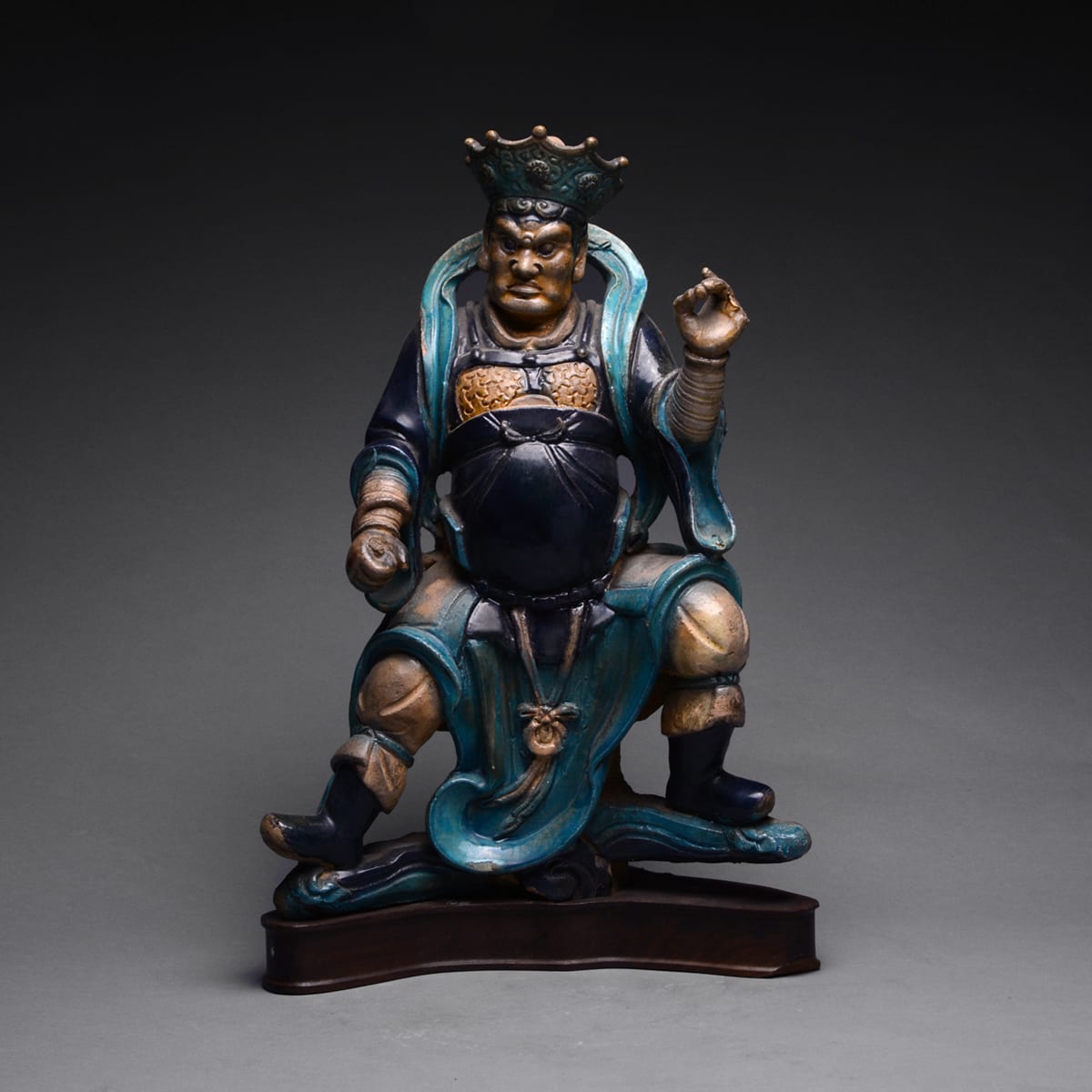Ming Dynasty Glazed Terracotta Roof Tile of Heavenly King, 1368 CE to 1644 CE
Glazed Terracotta
43.2 x 29.2 cm
17 x 11 1/2 in
17 x 11 1/2 in
PH.0301
Further images
The Ming dynasty, officially the Great Ming, was the ruling dynasty of China from 1368 to 1644 following the collapse of the Mongol-led Yuan dynasty. The Ming dynasty was the...
The Ming dynasty, officially the Great Ming, was the ruling dynasty of China from 1368 to 1644 following the collapse of the Mongol-led Yuan dynasty. The Ming dynasty was the last imperial dynasty of China ruled by Han Chinese. Literature, painting, poetry, music, and Chinese opera of various types flourished during the Ming dynasty. Especially, the period was renowned for ceramics, porcelains and glazed terracotta.
During the Ming Dynasty, the glazed terracotta tiles were used to decorate important buildings such as palaces and temples. The ridges and eaves were often decorated with popular gods, powerful warriors and fantastic animals. This artwork, which depicts one of the Four Heavenly Kings or Heavenly General through elaborate sculptures and colorful glaze, is part of the Ming Dynasty architecture. The rope-like figure around his right arm is presumed to be a serpent (or dragon), and his right hand probably holds the lower part of the serpent’s head, which is now gone. With the left hand upraised, he holds a pearl. The serpent (or dragon) and pearl are symbols of Virupaksha, one of the Four Heavenly Kings, therefore, it can be seen that the statue described Virupaksha. Although the attribute in his hand has partially disappeared, it rather stimulates our imagination. The crown adorned with his head and the shawl around his shoulders indicate the high authority of Heavenly King, and a strict facial expressions and hard armor reveal powerful force. It functioned as a guardian, defeating evil spirits and attracting blessings or good fortune.
This Ming tile of Heavenly King is astonishingly well preserved, even though it once adorned on the roof of a building. It is a kind of Ming Sancai, which is made by using a technique called Fahua. The craftsmen of the Ming Dynasty used both cast frames and manual work to create this delicate design and baked at a high temperature. This was then painted in splendid green, yellow and blue glazes and baked again at low temperatures. Other Ming dynasty terracotta tiles in the shape of dragons, symbolic characters, horses and riders can also be seen in Barakat collection.
(Reference: Clarence Eng. Colours and Contrast : Ceramic Traditions in Chinese Architecture. Brill, 2014; Timothy Brook. The Confusions of Pleasure: Commerce and Culture in Ming China. Berkeley: University of California Press, 1998.)
During the Ming Dynasty, the glazed terracotta tiles were used to decorate important buildings such as palaces and temples. The ridges and eaves were often decorated with popular gods, powerful warriors and fantastic animals. This artwork, which depicts one of the Four Heavenly Kings or Heavenly General through elaborate sculptures and colorful glaze, is part of the Ming Dynasty architecture. The rope-like figure around his right arm is presumed to be a serpent (or dragon), and his right hand probably holds the lower part of the serpent’s head, which is now gone. With the left hand upraised, he holds a pearl. The serpent (or dragon) and pearl are symbols of Virupaksha, one of the Four Heavenly Kings, therefore, it can be seen that the statue described Virupaksha. Although the attribute in his hand has partially disappeared, it rather stimulates our imagination. The crown adorned with his head and the shawl around his shoulders indicate the high authority of Heavenly King, and a strict facial expressions and hard armor reveal powerful force. It functioned as a guardian, defeating evil spirits and attracting blessings or good fortune.
This Ming tile of Heavenly King is astonishingly well preserved, even though it once adorned on the roof of a building. It is a kind of Ming Sancai, which is made by using a technique called Fahua. The craftsmen of the Ming Dynasty used both cast frames and manual work to create this delicate design and baked at a high temperature. This was then painted in splendid green, yellow and blue glazes and baked again at low temperatures. Other Ming dynasty terracotta tiles in the shape of dragons, symbolic characters, horses and riders can also be seen in Barakat collection.
(Reference: Clarence Eng. Colours and Contrast : Ceramic Traditions in Chinese Architecture. Brill, 2014; Timothy Brook. The Confusions of Pleasure: Commerce and Culture in Ming China. Berkeley: University of California Press, 1998.)





